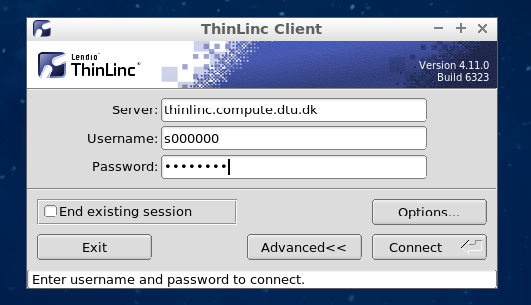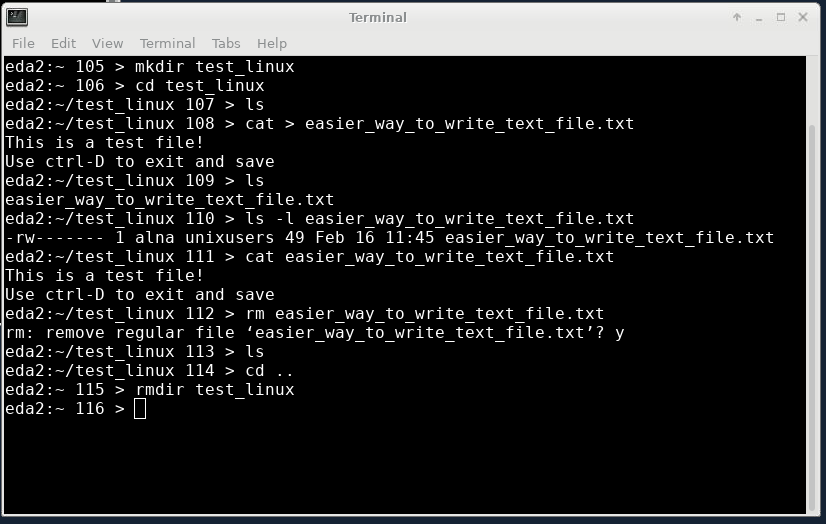Labs General Instructions
The tutorials and labs are based on the Synopsys suite of tools that run on machines with the Linux operating system.
In the course, we use two servers eda1.compute.dtu.dk and eda2.compute.dtu.dk to which you can remotely connect with your laptop/PC.
If you are not familiar with Linux/UNIX, you can check out this handout of the most useful UNIX commands.
1. Access to eda1/eda2 Servers
The two servers used to run the EDA tools are: eda1 and eda2.
The servers are identical and to balance the load on these,
let's adopt the rule:
- Groups with odd group number shall work on eda1.
- Groups with even group number shall work on eda2.
1.1 Remote Access by Thinlinc
Access by Thinlinc is considered the default access mode to the servers.
- Go to http://www.cendio.com/thinlinc/download and download the ThinLinc client for your OS.
- To connect to the DTU Compute servers, you
must be connected at the network at DTU Campus or via VPN (if not at DTU Campus).
From Outside DTU (e.g., from home) to connect via VPN, see https://www.inside.dtu.dk/da/medarbejder/it-og-telefoni/it-support-og-kontakt/it-systemer-og-vaerktoejer/it-systemer-ait/vpn
Note, the VPN requires MFA authentication (same as to webmail).
- Install ThinLinc and launch the application
-
Connect to thinlinc.compute.dtu.dk with your credentials

- Select the window manager (e.g., XFCE)
-
In the menu select:
Applications → DTU Compute (choose eda1 or eda2)
1.2 Remote Access by X2Go - May Not Work in some OSs
If you are "fluent" with Linux, you can try to connect to the eda servers
by X2Go.
X2Go provides clients for the main operating systems, but sometimes the remote connection does not work properly. Try at your own risk.
- Install and configure the X2Go client
- From Outside DTU (e.g., from home) to connect via VPN, see https://www.inside.dtu.dk/da/medarbejder/it-og-telefoni/it-support-og-kontakt/it-systemer-og-vaerktoejer/it-systemer-ait/vpn
- Connect to X2Go server
on either eda1 or eda2.
Detailed instructions to remotely connect by X2Go to eda servers.
2. Getting Started with EDA Tutorials and Labs
Now that you have gained access to one of the eda servers, you can set up the working space for labs and tutorials.
If you are new to Linux, we suggest you exercise some of the main Unix/Linux commands in a terminal window. Below are some examples of the basic commands:
- mkdir name → creates a directory name
- cd name → change to directory name
- ls → list files in working directory
- cat > file-name → easiest way to create a text file. To save and exit, press CTRL-D
- rm file-name → delete file file-name

A list of the most useful UNIX commands can be downloaded here.
2.1 Choosing the "shell"
A shell is a interpreter for commands given in a terminal line.
Linux provides several types of shells.
By default, the accounts are created in the bash shell. However, the tutorials are developed for the tcsh shell.
Commands for the tcsh shell are given in light yellow background in the tutorials
| eda2> ls |
Commands for the bash shell are given in orange background in the tutorials
| bash-4.2$ ls |
If you use a different shell, such as bash, you can switch to the tcsh shell by giving the command
|
Otherwise, you can modify the script files to adapt them to your shell (for advanced Linux users).
2.2 Tutorial Unit
The tutorial is based on a floating-point (FP) multiplier described in
Tutorial T1.
You are strongly advised to read Tutorial T1 before starting the tutorials.
2.3 Tutorials/Labs File-system Organization
When you login on one of the eda servers, the starting location is your HOME.
To determine the location of your HOME in the file-system you can type
| eda2>
echo $HOME /home/s000000 |
If you get lost in the file-system, you can easily go back to your home by:
| eda2>
cd |
To verify your position in the file-system type: pwd (it stands for print work directory).
| eda2>
pwd /home/s000000 |
We created a special area of the file-system for 02205 group work where both group members can create/modify files and directories in /dtu-compute/02205/
For example, the space for group 00 is /dtu-compute/02205/2024g-00 and the command to go to this directory is
| eda2>
cd /dtu-compute/02205/2024g-00 eda2> pwd /dtu-compute/02205/2024g-00 |
If you want to run the tutorials in the shared group space, you can copy the necessary files by the command
| eda2>
cp -r /apps/misc/02205/tutorial . eda2> ls ... tutorial ... |
You should use this space for group work and create directories for the tutorial and the labs. For example, your group space should have the 4 directories: tutorial, lab1, lab2 and lab3 at the end of course.
2.4 Synopsys' Environment Set-up
Synopsys' tools require to set-up some environment variables and the proper license to work.
In each tutorial, the scripts to set-up the specific tool are given.
The table below lists the tools used in the tutorials. The set-up scripts are in directory /apps/misc/02205/scripts.
| Task | Tool | Version | Tutorial(s) | Set-up (tcsh) | Set-up (bash) |
|---|---|---|---|---|---|
| Simulation | VCS | S-2021.09-SP1-1 | 2, 4, 5, 6 | setup_synopsys_vcs.csh | setup_synopsys_vcs.sh |
| Synthesis | Design Compiler/Vision | G-2012.06 | 3, 4, 5 | setup_synopsys_dv.csh | setup_synopsys_dv.sh |
| Place & Route | IC Compiler | R-2020.09-SP5-5 | 5, 6 | setup_icc.csh | setup_icc.sh |
| Spice sim. | HSPICE | L-2016.03 | 6 | setup_spice.csh |
2.5 Tutorial Entry Point
The entry point for the tutorial is
The tutorial website is behind the DTU firewall and you must have a VPN active to access the site.
Modified by Alberto Nannarelli on
Sunday February 18, 2024 at 18:47